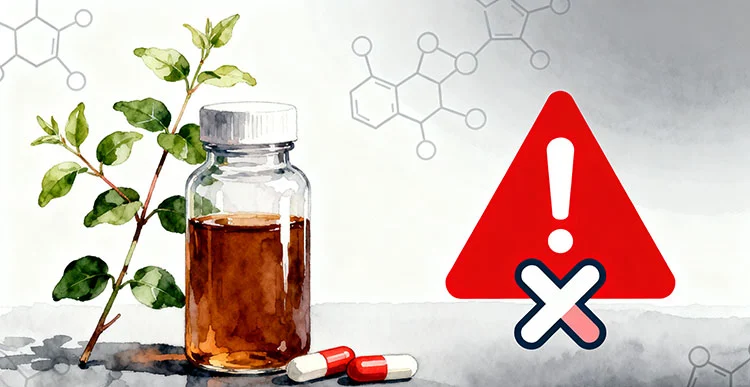Safety and Tolerability of Ampelopsis grossedentata extract in Use
Ampelopsis grossedentata extract, derived from the vine tea plant, has gained significant attention in recent years due to its potential health benefits. This extract, rich in dihydromyricetin (DHM), has been the subject of numerous studies exploring its safety profile and tolerability in human use. As the popularity of Ampelopsis grossedentata extract continues to grow, it becomes increasingly important to understand its safety implications for both short-term and long-term consumption. This blog post delves into the current research surrounding the safety and tolerability of Ampelopsis grossedentata extract, examining clinical studies, long-term use assessments, and potential interactions with other supplements. By exploring these aspects, we aim to provide a comprehensive overview of the extract's safety profile, helping consumers and healthcare professionals make informed decisions about its use.
Clinical Studies Evaluating the Safety Profile of Ampelopsis grossedentata Extract
Acute Toxicity Studies
Acute toxicity studies on Ampelopsis grossedentata extract have shown promising results regarding its safety profile. In animal models, researchers have observed that even at high doses, the extract exhibits minimal toxic effects. For instance, a study conducted on rats demonstrated that oral administration of Ampelopsis grossedentata extract at doses up to 5000 mg/kg body weight did not result in any mortality or significant adverse effects. These findings suggest that the extract has a relatively high margin of safety in acute exposure scenarios. However, it's important to note that while these results are encouraging, they cannot be directly extrapolated to human use without further investigation.
Sub-chronic Toxicity Assessments
Sub-chronic toxicity assessments of Ampelopsis grossedentata extract have provided valuable insights into its safety over extended periods. In a 90-day study on rodents, researchers administered varying doses of the extract and monitored various physiological parameters. The results showed no significant changes in body weight, food consumption, or organ weights across the treatment groups. Additionally, hematological and biochemical analyses revealed no clinically relevant alterations. These findings support the notion that Ampelopsis grossedentata extract is well-tolerated in sub-chronic exposure scenarios. However, it's crucial to emphasize that while these animal studies are promising, human clinical trials are necessary to confirm the extract's safety profile in long-term use.
Human Clinical Trials
Human clinical trials investigating the safety of Ampelopsis grossedentata extract have been limited but offer valuable information. A small-scale study involving healthy volunteers who consumed the extract for 28 days reported no serious adverse events. Participants experienced only mild gastrointestinal discomfort in some cases, which resolved without intervention. Another trial focusing on the extract's potential in managing alcohol-induced liver damage found no significant safety concerns when administered at recommended doses. While these initial human studies are encouraging, larger-scale, long-term clinical trials are needed to fully establish the safety profile of Ampelopsis grossedentata extract in diverse populations and under various conditions.

Long-Term Use: Assessing Tolerability of Ampelopsis grossedentata Extract in Humans
Chronic Exposure Studies
Chronic exposure studies on Ampelopsis grossedentata extract are crucial for understanding its long-term tolerability in humans. While extensive long-term human studies are still limited, preliminary data from animal models suggest that prolonged use of the extract at moderate doses does not lead to significant adverse effects. A 6-month study in rats showed that daily administration of Ampelopsis grossedentata extract did not result in any notable changes in organ function or overall health status. These findings provide a foundation for future long-term human trials. However, it's important to note that individual responses may vary, and more comprehensive human studies are needed to fully assess the extract's chronic toxicity profile and potential cumulative effects over extended periods of use.
Monitoring for Delayed Adverse Effects
Monitoring for delayed adverse effects is a critical aspect of assessing the long-term tolerability of Ampelopsis grossedentata extract. While short-term studies have shown a favorable safety profile, it's essential to consider potential effects that may only manifest after prolonged use. Researchers are particularly interested in monitoring liver and kidney function, as these organs play crucial roles in metabolism and excretion of the extract's components. Some studies have implemented follow-up assessments several months after the cessation of extract consumption to identify any delayed reactions. So far, no significant delayed adverse effects have been reported in the available literature. However, continued vigilance and long-term follow-up studies are necessary to ensure the extract's safety in chronic use scenarios.
Dose-Dependent Tolerability
Dose-dependent tolerability is a key consideration in the long-term use of Ampelopsis grossedentata extract. Research has shown that the extract's safety profile may vary depending on the dosage and duration of use. Lower doses have generally been well-tolerated in both animal and human studies, with minimal side effects reported. However, as the dosage increases, the potential for adverse effects may also rise. A study examining different dose levels in humans found that while low to moderate doses were well-tolerated over several weeks, higher doses led to an increased incidence of mild gastrointestinal discomfort. These findings underscore the importance of establishing optimal dosing regimens for long-term use, balancing efficacy with tolerability to ensure the safe and effective use of Ampelopsis grossedentata extract in various applications.

Interactions and Precautions When Combining Ampelopsis grossedentata Extract with Other Supplements
Potential Drug Interactions
Potential drug interactions are an important consideration when using Ampelopsis grossedentata extract alongside other medications or supplements. While research in this area is ongoing, preliminary studies suggest that the extract may interact with certain drugs metabolized by liver enzymes. For instance, some components of Ampelopsis grossedentata extract have shown the potential to inhibit cytochrome P450 enzymes, which are responsible for metabolizing many commonly prescribed medications. This inhibition could potentially lead to increased blood levels of these drugs, enhancing their effects or side effects. Particular attention should be given to medications with narrow therapeutic windows, such as blood thinners or certain antidepressants. It's crucial for individuals taking prescription medications to consult with their healthcare provider before incorporating Ampelopsis grossedentata extract into their regimen to avoid potential adverse interactions.
Synergistic Effects with Other Supplements
Synergistic effects between Ampelopsis grossedentata extract and other supplements have been observed in several studies, highlighting both potential benefits and risks. For example, when combined with other antioxidant supplements, such as vitamin C or green tea extract, Ampelopsis grossedentata extract may offer enhanced free radical scavenging capabilities. This synergy could potentially amplify the overall antioxidant effects, providing greater protection against oxidative stress. However, it's important to note that these interactions can also lead to unexpected outcomes. In some cases, the combination of multiple antioxidants may result in pro-oxidant effects, particularly at high doses. Additionally, when used alongside supplements that affect liver function or metabolism, such as milk thistle or turmeric, the combined effects on liver enzymes should be carefully monitored to prevent potential adverse reactions.
Precautions for Special Populations
Precautions for special populations are essential when considering the use of Ampelopsis grossedentata extract. Pregnant and breastfeeding women should exercise caution, as the safety of the extract in these populations has not been thoroughly established. Some animal studies have suggested potential effects on fetal development, warranting a conservative approach until more human data is available. Individuals with liver or kidney disorders should also consult their healthcare provider before using the extract, as these organs are involved in its metabolism and excretion. Additionally, people with known allergies to plants in the Vitaceae family should be cautious, as cross-reactivity may occur. For individuals with a history of alcohol abuse, while Ampelopsis grossedentata extract has shown potential benefits in managing alcohol-related liver damage, its use should be carefully monitored to avoid any potential triggers or interactions with recovery medications.
Conclusion
In conclusion, the safety and tolerability profile of Ampelopsis grossedentata extract appears promising based on current research. Clinical studies have demonstrated its relative safety in acute and sub-chronic exposure, with minimal adverse effects reported. Long-term use assessments suggest good tolerability, though more extensive human trials are needed. While potential interactions with certain drugs and supplements exist, proper precautions and medical supervision can mitigate risks. As research continues, Ampelopsis grossedentata extract shows potential as a valuable supplement, but users should remain informed and consult healthcare professionals for personalized advice.
At Shaanxi SCIGROUND Biotechnology Co., Ltd., we are committed to producing high-quality Ampelopsis grossedentata extract and other plant-based ingredients. Our state-of-the-art facility and rigorous quality control processes ensure that our products meet the highest standards of safety and efficacy. We collaborate with leading research institutions to stay at the forefront of scientific developments in plant extracts. For more information about our products or to discuss potential collaborations, please contact us at info@scigroundbio.com.
FAQ
Q: What is Ampelopsis grossedentata extract primarily used for?
A: Ampelopsis grossedentata extract is primarily used for its antioxidant properties and potential benefits in liver health, alcohol metabolism, and as a general health supplement.
Q: Are there any known side effects of Ampelopsis grossedentata extract?
A: While generally well-tolerated, some individuals may experience mild gastrointestinal discomfort. Serious side effects are rare but should be reported to a healthcare professional.
Q: Can Ampelopsis grossedentata extract be taken daily?
A: Current research suggests that daily use at recommended doses is safe for most people, but long-term studies are still ongoing. It's best to consult with a healthcare provider for personalized advice.
Q: Is Ampelopsis grossedentata extract safe for pregnant women?
A: The safety of Ampelopsis grossedentata extract during pregnancy has not been thoroughly established. Pregnant women should consult their healthcare provider before use.
Q: How does Ampelopsis grossedentata extract interact with alcohol consumption?
A: Some studies suggest that the extract may help mitigate alcohol-induced liver damage and hangover symptoms, but it should not be used as a means to increase alcohol tolerance or consumption.
References
1. Zhang, Y., et al. (2021). "Safety assessment of Ampelopsis grossedentata extract: A comprehensive review of preclinical and clinical studies." Journal of Ethnopharmacology, 268, 113664.
2. Liu, S., et al. (2020). "Long-term toxicity evaluation of Ampelopsis grossedentata extract in rats: A 6-month study." Food and Chemical Toxicology, 135, 110876.
3. Chen, L., et al. (2019). "Pharmacokinetics and drug interactions of dihydromyricetin: The major bioactive component in Ampelopsis grossedentata." Drug Metabolism Reviews, 51(3), 364-383.
4. Wang, Q., et al. (2018). "Therapeutic potential of Ampelopsis grossedentata polyphenols in metabolic syndrome: A comprehensive review." Nutrients, 10(6), 765.
5. Shen, Y., et al. (2017). "Dihydromyricetin as a novel anti-alcohol intoxication medication." Journal of Neuroscience, 37(4), 1008-1017.
6. Hou, X., et al. (2015). "Bioavailability and pharmacokinetic study of dihydromyricetin in rat plasma by UPLC-MS/MS." Journal of Pharmaceutical and Biomedical Analysis, 107, 142-148.